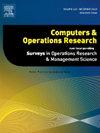铁路时刻表规划中的地理分解:建模与计算评估
IF 4.3
2区 工程技术
Q2 COMPUTER SCIENCE, INTERDISCIPLINARY APPLICATIONS
引用次数: 0
摘要
铁路时刻表规划是铁路运营的核心,旨在有效利用基础设施容量,为客户提供快速、准时、可靠的服务。时间表由可行的列车时刻表组成,遵守操作约束并满足一定的质量目标,铁路网络的复杂性和规模需要先进的算法来处理大规模实例。为此,已经开发了分解方法,例如利用问题的地理结构,将问题划分为更易于管理的较小区域或车站和路口。然而,这些特定的选择如何在不同程度上平衡解决分解子问题的计算工作量,而不是将它们协调到全局最优解,这仍然是一个悬而未决的问题。在本文中,我们进行了广泛的计算分析,以评估瑞士联邦铁路现实案例研究中不同分解情景的影响。为此,我们在现有的基于逻辑的铁路时间表规划Benders分解框架上,基于系统算法方法建模并实现自动地理分解架构。特别是,我们探索了一个基于区域聚合到更大区域的过程,以生成一组分解。利用随机森林的计算分析结果表明,在具有相对较小的主问题的少量大面积区域的分解中,具有最小化运行时间的潜力,促进了主问题与子问题之间更简单的协调机制,这极大地影响了解决问题实例的计算工作量。尽管如此,尽管在解决时间表问题的不同分解所需的计算工作量的因素贡献中发现了可解释性,但分析也揭示了多个因素之间的复杂关系。本文章由计算机程序翻译,如有差异,请以英文原文为准。
Geographic decompositions in railway timetable planning: Modelling and computational assessment
Railway timetable planning is the core of railway operations, which aims to make efficient use of infrastructure capacity and provide fast, punctual, and reliable services for customers. A timetable consists of a feasible train schedule adhering to operational constraints and meeting certain quality objectives, and the complexity and scale of railway networks require advanced algorithms to address large-scale instances. For this, decomposition approaches have been developed, exploiting for instance the geographical structure of the problem by partitioning the problem into more manageable smaller areas or stations and junctions. Nevertheless, it remains an open question how these specific choices balance to a different extent the computation effort to solve decomposed subproblems versus coordinating them towards a global, optimal solution. In this paper, we carry out an extensive computational analysis to evaluate the effects of diverse decomposition scenarios in a real-life case study of the Swiss Federal Railways. For this, we model and implement automatic geographic decomposition architectures based on a systematic algorithmic approach, on an existing logic-based Benders decomposition framework for railway timetable planning. In particular, we explore a process based on aggregation of areas into larger areas to generate a set of decompositions. The results of the computational analysis by means of random forests show the potential to minimize runtimes in decompositions with small number of large-sized areas with a relatively small master problem, facilitating a simpler coordination mechanism between master problem and subproblems, which strongly influences the computational effort to solve problem instances. Nonetheless, despite finding explainability in the contributions of factors to the computational effort required to solve different decompositions of the timetabling problem, the analysis also reveals complex relationships between multiple factors.
求助全文
通过发布文献求助,成功后即可免费获取论文全文。
去求助
来源期刊

Computers & Operations Research
工程技术-工程:工业
CiteScore
8.60
自引率
8.70%
发文量
292
审稿时长
8.5 months
期刊介绍:
Operations research and computers meet in a large number of scientific fields, many of which are of vital current concern to our troubled society. These include, among others, ecology, transportation, safety, reliability, urban planning, economics, inventory control, investment strategy and logistics (including reverse logistics). Computers & Operations Research provides an international forum for the application of computers and operations research techniques to problems in these and related fields.
 求助内容:
求助内容: 应助结果提醒方式:
应助结果提醒方式:


